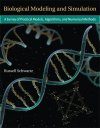![Biological Modeling and Simulation Biological Modeling and Simulation]()
Click to have a closer look
About this book
Biography
Related titles
About this book
There are many excellent computational biology resources now available for learning about methods that have been developed to address specific biological systems, but comparatively little attention has been paid to training aspiring computational biologists to handle new and unanticipated problems.
Biological Modeling and Simulation is intended to fill that gap by teaching students how to reason about developing formal mathematical models of biological systems that are amenable to computational analysis. It collects in one place a selection of broadly useful models, algorithms, and theoretical analysis tools normally found scattered among many other disciplines. It thereby gives the aspiring student a bag of tricks that will serve him or her well in modeling problems drawn from numerous subfields of biology. These techniques are taught from the perspective of what the practitioner needs to know to use them effectively, supplemented with references for further reading on more advanced use of each method covered.
Biological Modeling and Simulation, which grew out of a class taught at Carnegie Mellon University, covers models for optimization, simulation and sampling, and parameter tuning. These topics provide a general framework for learning how to formulate mathematical models of biological systems, what techniques are available to work with these models, and how to fit the models to particular systems. Their application is illustrated by many examples drawn from a variety of biological disciplines and several extended case studies that show how the methods described have been applied to real problems in biology.
Customer Reviews
Biography
Russell Schwartz is Associate Professor in the Department of Biological Sciences at Carnegie Mellon University.
Handbook / Manual
Out of Print
By: Russell Schwartz(Author)
389 pages, 111 b/w illustrations
"In twenty-first-century biology, modeling has a similar role as the microscope had in earlier centuries; it is arguably the most important research tool for studying complex phenomena and processes in all areas of the life sciences, from molecular biology to ecosystems analysis. Every biologist therefore needs to be familiar with the basic approaches, methods, and assumptions of modeling. Biological Modeling and Simulation is an essential guide that helps biologists explore the fundamental principles of modeling. It should be on the bookshelf of every student and active researcher."
– Manfred D. Laubichler, School of Life Sciences, Arizona State University, and co-editor of Modeling Biology
"Russell Schwartz has produced an excellent and timely introduction to biological modeling. He has found the right balance between covering all major developments of this recently accelerating research field and still keeping the focus and level of the book at a level that is appropriate for all newcomers."
– Zoltan Szallasi, Children's Hospital, Boston



































